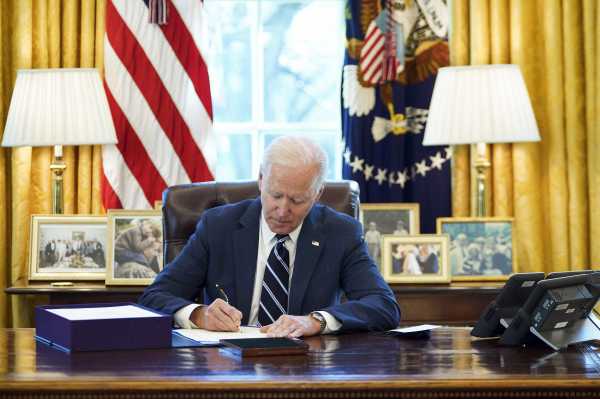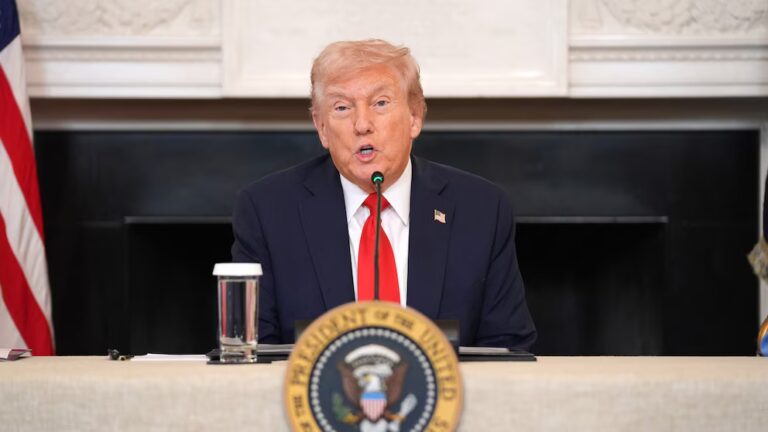
Joe Biden has signed the $1.9 trillion Covid-19 relief package after weeks of back-and-forth debate in Congress, and one year to the day after the World Health Organization declared a pandemic.
The American Rescue Plan, which Biden first unveiled in January, will deliver aid to millions of Americans and inject funds across the economy as the country continues to steer its way out of the pandemic.
“I believe this is — and most people I think do as well — this historic legislation is about rebuilding the backbone of this country and giving people in this nation, working people, the middle-class folks, people who built the country, a fighting chance,” Biden said while signing the bill Thursday. “That’s what the essence of it is.”
The legislation passed the House of Representatives on Wednesday by 220-211 vote after the Senate approved it over the weekend. No Republicans in the House or the Senate supported the package.
To get a sense of how massive the bill is: The recovery package Democrats passed during the Great Recession in 2009 was about 5.5 percent of 2008’s GDP; the American Rescue Plan is 9 percent of 2020’s GDP. And much of the money is going to those who need it most.
The bill includes $1,400 stimulus checks to most Americans. The full checks will go out to single people making up to $75,000 and couples making up to $150,000, and phase out at $80,000 and $160,000, based on 2019 or 2020 tax returns, depending on when people last filed their taxes. Previous checks phased out at higher income levels, meaning some people who got checks in previous rounds won’t get them this time. However, the legislation includes checks for adult dependents, such as college students and people with disabilities, for the first time.
Related
When to expect your stimulus check, and other questions, answered
Expanded and extended unemployment insurance under the legislation will last through September 6, with unemployed workers receiving an extra $300 a week in federal benefits. Importantly, the bill includes a provision that makes the first $10,200 in unemployment benefits nontaxable for households making up to $150,000. Also on the tax front, the legislation makes student loan forgiveness tax-free through 2025 — a way for Democrats to nudge the president on student debt cancellation and a policy change experts hope will stick regardless.
The White House estimates that the legislation, which includes an expanded child tax credit, will cut child poverty in half. The bill includes $170 billion for schools, $100 billion for public health, and $350 billion for state and local government aid — an issue that has been a major sticking point for Republicans. It increases Affordable Care Act subsidies and COBRA subsidies for people who have lost their jobs, contains funds for restaurants, and has all sorts of funds aimed at helping people get by, such as rental assistance and help paying for water and energy bills.
Some portions of the bill didn’t end up being as generous as they were when it was first proposed after push-and-pull with moderate Democrats. Biden initially wanted $400 in extra unemployment through September. However, the unemployment tax provision was only added in the Senate legislation, saving people from getting a surprise tax bill they might not be able to pay for. A $15 federal minimum wage was also struck from the legislation. The Senate parliamentarian ruled it could not be done through budget reconciliation — the process Democrats used to pass the bill — and the Senate voted down an amendment to put a $15 minimum wage back into the bill.
Democrats don’t want a repeat of 2009
The US has been in the midst of the pandemic for about a year, and the federal government has passed multiple pieces of legislation aimed at helping soften the blow to the economy, including businesses, families, and workers. The mantra among many economists — and one adopted by Biden — is that the risk is really doing too little, not too much, in response to the pandemic.
Sign up for The Weeds newsletter
Vox’s German Lopez is here to guide you through the Biden administration’s unprecedented burst of policymaking. Sign up to receive our newsletter each Friday.
Democrats and Biden also remember the bill they passed to help the country out of the Great Recession. They thought they’d get to take a swing at follow-up stimulus legislation and then didn’t, so the impetus was to do as much as they could this time around. There have been some naysayers about the size of the legislation, even among Democrats, but the White House has largely ignored them.
“One thing we learned is, you know, we can’t do too much here,” the president said while speaking to reporters in the Oval Office in February. “We can do too little. We can do too little and sputter.”
The package is really aimed at providing assistance to people at lower income levels and takes a bottom-up approach. According to an estimate from the Tax Policy Center, the poorest 20 percent of Americans will see a 20 percent boost to their after-tax income, and the second quintile of earners will see their income go up by nearly 10 percent. Meanwhile, the highest earners — many of whom are doing financially better during the pandemic — won’t see much, if any, change. It’s quite a contrast to the tax cut bill Republicans passed through budget reconciliation in 2017, the benefits of which went disproportionately to corporations and the rich.
Now that Biden has signed the legislation, it will take some time to get the money out the door and programs put in place. But for millions of people, more help is on the way.
Millions turn to Vox to understand what’s happening in the news. Our mission has never been more vital than it is in this moment: to empower through understanding. Financial contributions from our readers are a critical part of supporting our resource-intensive work and help us keep our journalism free for all. Help us keep our work free for all by making a financial contribution from as little as $3.
Sourse: vox.com






